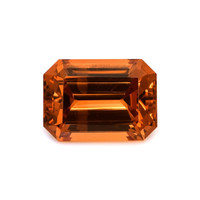Introduction to Garnet
Welcome to ‘Introduction to Garnet,’ the fascinating world of garnets, a gemstone cherished through the ages for its striking beauty and rich variety. This introduction aims to illuminate the captivating nature of garnet, a true treasure of the earth, for gem enthusiasts and curious minds alike.

What is a Garnet?
Garnet is a diverse gemstone family known for its wide range of colors—from classic deep reds to exotic greens, oranges, and rare blues—each variety defined by its unique chemical composition. The most common garnets in jewelry include almandine (deep reds), pyrope (vibrant tones), and rhodolite (purplish-red hues), while tsavorites and demantoid garnets are valued for their bright green colors and rarity. Garnets are not only prized for their beauty but also for their durability (Mohs hardness of 6.5 to 7.5) and brilliant luster, enhanced by high refractive indices. Found across various global locations like Africa, India, Russia, and South America, each source adds to the gem’s rich diversity. Garnets’ versatility and timeless appeal make them a favored choice for all types of jewelry, embodying a special place in gemstone history and culture.
Brief history of Garnet in human culture
The history of garnet, a gemstone as old as civilization itself, begins in the mists of antiquity. Garnets have been discovered in Bronze Age burial sites, indicating their use as adornments and symbols of power and permanence. Ancient Egyptians, as early as 3100 BC, revered garnets as symbols of life and used them in intricate jewelry and carvings. These deep red stones were believed to represent the vitality of life and the endurance of the soul, thus were frequently found in pharaohs’ tombs, accompanying them into the afterlife.
Garnet in the Classical World
The allure of garnet continued into the Classical era, where it gained prominence in Ancient Rome and Greece. Roman scholars, such as Pliny the Elder, wrote extensively about garnets, noting their popularity in signet rings used for imprinting seals in wax – a testament to the stone’s hardness and durability. The Greeks also adorned themselves with garnet jewelry, valuing the stone for its beauty and supposed protective powers. Garnets were often associated with strength and safety, particularly in travels and ventures.
The Middle Ages and Garnet

In the Middle Ages, garnet’s significance evolved to symbolize nobility and authority. European royalty and clergy favored these stones in their regalia and sacred relics. Garnets were set in crowns, rings, and other symbols of power, their deep red hue seen as a representation of influence and importance. This period also saw the belief in garnet’s protective powers grow; it was thought to ward off pestilence, soothe the heart, and prevent nightmares.
Garnet in Eastern Cultures
The history of garnet extends beyond the Western world. In Asian cultures, garnets were revered for their supposed mystical properties. They were believed to provide guidance in the night, acting as a light source for travelers and a protector against evil spirits. In Hindu and Buddhist traditions, garnets were valued not just for their physical beauty, but also for their spiritual significance, often used in sacred ornaments and talismans.
Garnet’s Enduring Legacy in Modern Times
In our ‘Introduction to Garnet,’ we explore how garnet remains a gemstone steeped in rich history and lore. Its journey through various cultures and ages has only added to its mystique and appeal. Garnets continue to be a popular choice for modern jewelry, with their deep reds and varied hues symbolizing love, passion, and vitality. As we reflect on the history of garnet in human culture, we are reminded of the timeless bond between human civilization and the fascinating world of gemstones.
Discover the world’s most elusive treasures in our exclusive guide on the Rarest Gemstones by Type!
